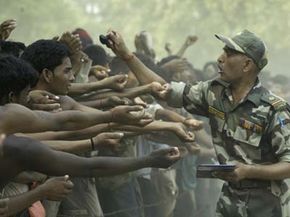There has scarcely been a time in human history when rival factions haven't clashed over territory, resources and ideology. The evolution of warfare has closely shadowed the technological ascent of man, with each scientific advancement inevitably fitting into some new ingenuous scheme to spill blood, raze cities and reduce entire populations to ash.
As such, some sort of army or similar notion has marched side by side with us across the millennia. The weapons and tactics have changed, but the military remains the ultimate means of enforcing policy and protecting a nation's citizens, either by action or by threat.
Advertisement
But how do you fill an army's ranks? Largely, there are two schools of thought: conscripted armies and volunteer armies. Conscripted armies are either partially or entirely manned through compulsory military service. If you fit the desired requirements for service, then guess what -- you're in the army.
Of course, that's merely the basic model -- conscripted armies can take many forms. For instance, Israel requires military service of both sexes, while the United States has only drafted males during its periods of conscription. Similarly, desperate or embattled factions (such as Nazi Germany toward the end of World War II) have handed out guns to old men and youths. In the past, nations have also filled the rank and file of their armies with slaves or peasants, while reserving command roles for the ruling elite.
A volunteer army, on the other hand, depends on willing recruits. This basic model also varies from situation to situation. During a time of crisis, volunteers may be motivated by a sense of patriotic duty. The rest of the time, to win willing soldiers, military recruiters might have to pony up some serious compensation such as competitive pay, education and a promise of a better life.
Volunteer and conscripted armies litter the history books, as well as the day-to-day headlines. Examples of each exist on every occupied continent.
In this article, we'll examine the challenges of maintaining a volunteer army and what it takes to maintain its ranks.
Advertisement





